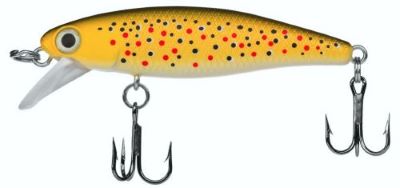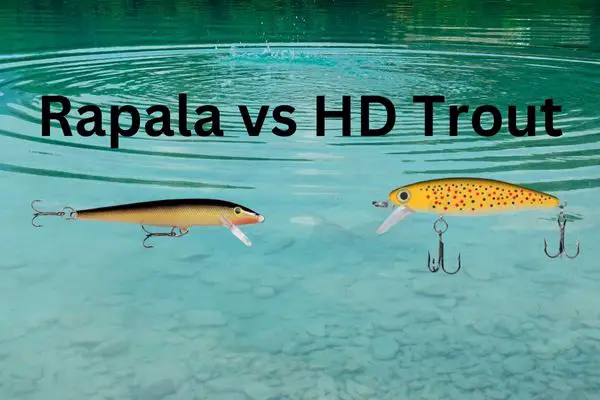A question I often get asked, is which jerkbait is best for trout fishing, and out of all jerkbaits I am asked to share my thoughts between Rapala’s and Dynamic Lures HD trout.
To start with Rapala produces a massive range of different jerkbaits, there is simply just not one Rapala lure. When people ask this question, I assume they mean the Oringal Floating Rapala vs the HD Trout.
But even then, it is not a head to head comparison. The Oringal Floating Rapala like the name suggests is a floating lure, while the HD trout is a slow sinker. They are fundamentally different lures. It might make more sense to compare it with the Rapala Countdown. Which is also a slow sinking lure.
So, I decided to compare the HD Trout against both the Original Floater, and the Rapala Countdown.
For more information on different jerkbaits for trout fishing, and how to fish them check out my guide here.

Size and weight
The length of the HD trout places it somewhere between a Rapala 5 and 7 size. This is a good thing, because these two Rapala sizes are among the most popular for trout fishing.
Now, there are certainly situations where a small CD01 or a long F11 might be the best option. So when trout are feeding on tiny prey, the HD trout is not really an option.
A F11 lure might sound a bit long for trout fishing, but I have caught trout of them. In discolored water, I do prefer a longer lure just to make it more visible.
| Length | Weight | Running Depth | |
| HD Trout | 2 1/4” | 1/10oz | 0-2’ |
| Original Floating F05 | 2” | 1/16oz | 3-5’ |
| Original Floating F07 | 2 3/4” | 1/8oz | 3-5’ |
| Countdown CD05 | 2” | 3/16oz | 3-6’ |
| Countdown Rapala CD07 | 2 3/4” | 1/4oz | 5-8’ |
Running Depth
The HD trout is a very shallow running jerkbait, while the actual running depth does vary, depending mostly on retrieval speed the HD trout consistently dives shallower than the Rapalas.
I fish Rapala often, and I rarely can get a floater to dive down to 5’, that figure sounds a bit optimistic to me, but I do find they do swim deeper than HD trouts. This can be useful, if the trout are holding close to the bottom.
On the other hand, if the stream is very shallow, the HD trout is a good option because it is less likely to snag on the bottom.
The HD trout is also a slow sinking lure, so with patience, it can certainly get a lot deeper than a floating Rapala. Simply cast out, wait a few seconds for it to sink before starting the retrieve.
So, in my experience. The main difference is that I prefer to fish HD trouts when casting across very shallow ripples or flats. Although, it is also possible to control the depth of a floating Rapala simply by pausing occasionally to get it to float off the bottom.

Does Rapalas or HD-trout have a better action?
I have said this before on previous articles, but the HD trout has an excellent wobble on a straight retrieve. It dances through the water shaking side to side. When I am just casting and retrieving, without working the rod I much prefer the action of the HD trout.
Now, unless i am trolling. I rarely just use a straight retrieve. I introduce jerks, twitches and pauses. During the jerk phase, I honestly prefer the action of the original floater. It is simply more aggressive.
Now, this is just my opinion. It is what the trout like which really matters. I have caught countless trout on both lures, both casting and trolling. Both straight, and jerking. They are both very effective actions and I am certainly in no position to claim one will result in more caught trout than the other.
Attraction and patterns?
Which has the better pattern and selections?
This really comes down to personal preference, or maybe trout preference. The patterns are actually very similar, they even come complete with scale patterns.
HD trout do come with a more modern looking eye, compared with the painted on eyes Rapala uses on their traditional models.
The detail of the paint work, is quite similar, but I have to give the edge to Rapala. In most cases, there seem to be more fine details. This also makes their lures look a little more lifelike. Although, there patterns often look nothing like the real thing?
I have never seen a 2” brook trout fry with an orange belly, green back and red dots, and likewise Brown trout and Rainbow trout look nothing like their representative patterns. When trying to imitate trout fry, I typically go for a pattern such as HD Trout Ghost Perch or Rapala Yellow Perch. To my eyes, these patterns better represent juvenile trout than their namesake lures.
Now, I have caught plenty of trout on their namesake lures. I suspect we care more about what lures look like than the trout actually do.
When fishing in dirty water, I like to use bright and bold patterns. I much prefer the HD trout patterns over Rapala. I do not know why, but Rapala simply lacks any obnoxiously high visibility patterns. I guess they might be slow sellers, but I find them to be very effective trout catchers. My pick for a dirty water pattern is the HD trout in Fire Craw. Although, the bright orange, but long discontinued Yo-zuri pattern was even better.
Construction and durability
I never had any durability issues with either brand, although eventually, after dozens of bites the paint or coating will start to scratch and peel off.
The Rapalas are made from balsa wood, which has a proven record for trout lures. While the HD trout are made from ABS plastic which is probably the material used in most jerkbaits today.
The HD trout does have one trick, which the rapalas lack. That being internal ball bearings. Not only do they add weight, assiting in casting, they also rattle and move around during the retrieve which just might grabs a trout attention.
Is Rapala or Dynamic Lures HD trout better for fishing dirty water?
I will personally go for a HD trout in Fire craw pattern. The bright orange makes the lure much easier to see through the murkey water. The internal rattle, from the ball bearings might also assist in the trout sensing the lure.
I can not locally buy Dynamic Lures HD Trout lures, is there a comparable Rapala?
Rapala does make the Ultralight Minnow. This lure shares many of the same characteristics. It comes in a similar size. Like the HD trout it is a slow sinking lure which is designed to swim relatively shallow. I do personally prefer the HD trout action over it.
Summary
They are both effective trout lures. Dynamic trout makes things simple with only a single size and weight which is suitable for most styles of trout fishing. Where the Dynamic trout HD trout excels when fishing shallow water, so a good choice for small streams or working the edge of a lake or larger river.
Rapala makes a massive range of trout lures, and they have an option for almost any style or type of fishing.
In conclusion, there is a time and place where I fish lures from both brands. I do prefer Dynamic Trout lures when fishing small streams, and I am starting to favor it more while trolling. In most other fishing situations, I still typically reach for rapalas or another jerkbait.

